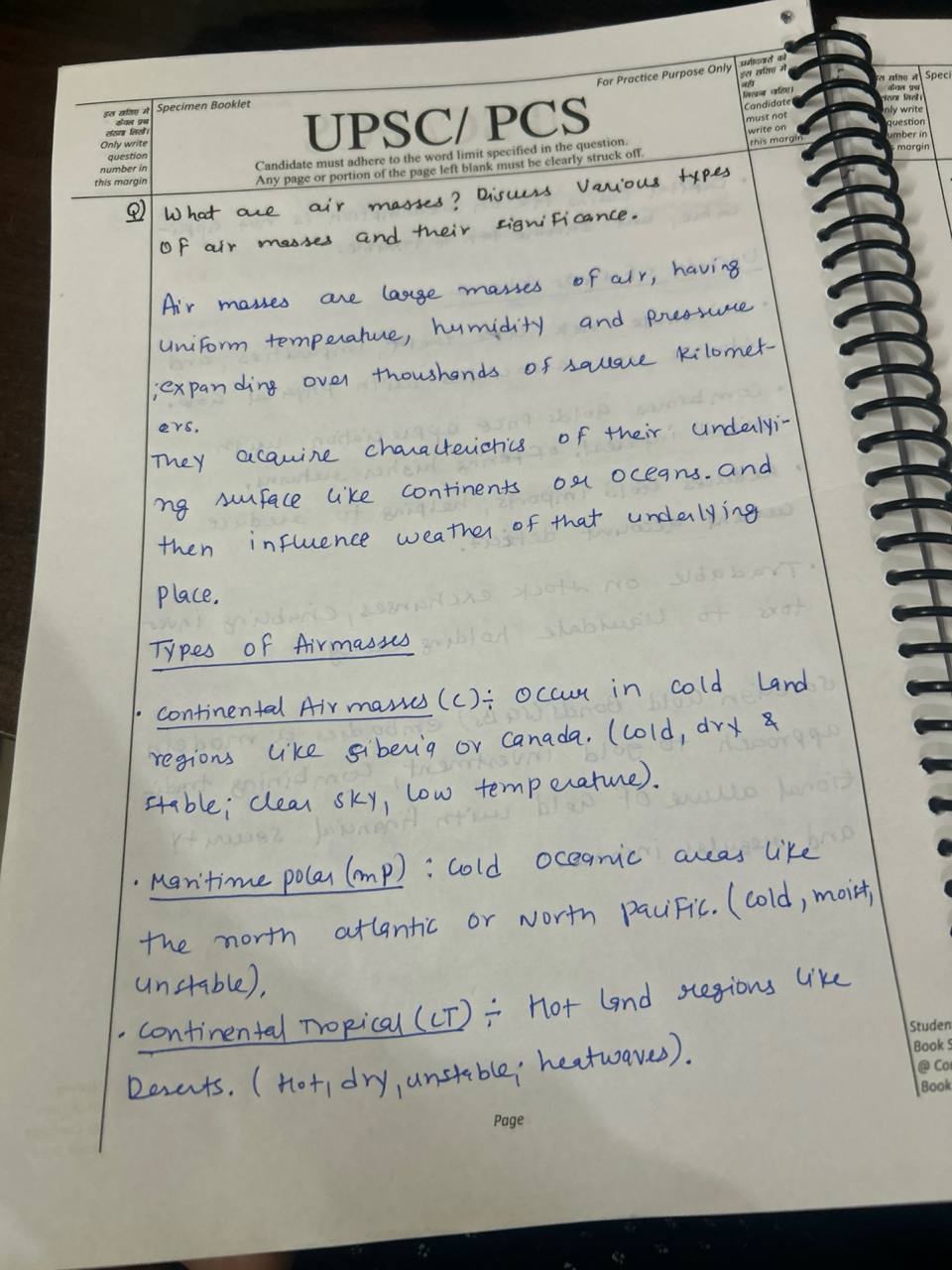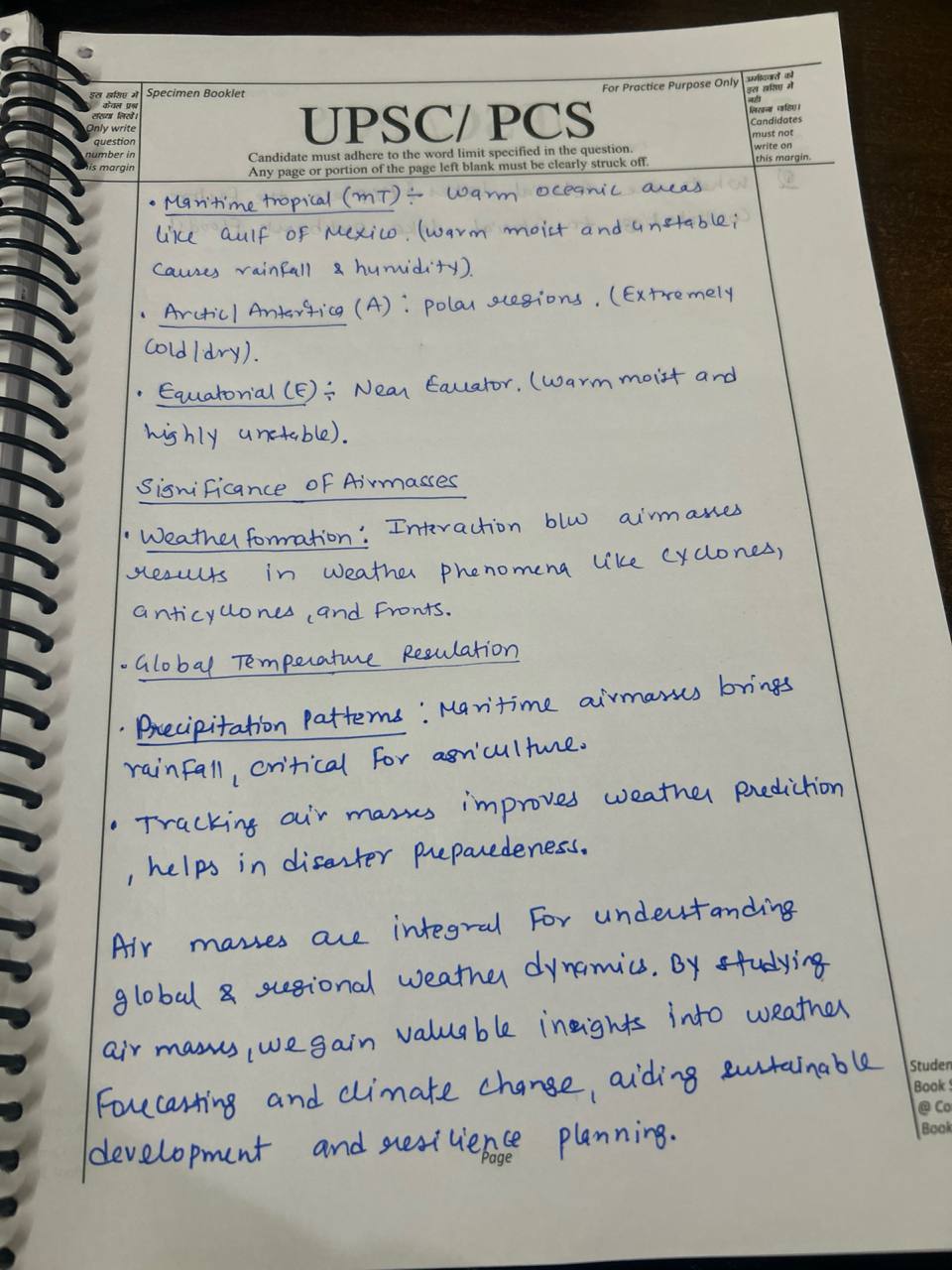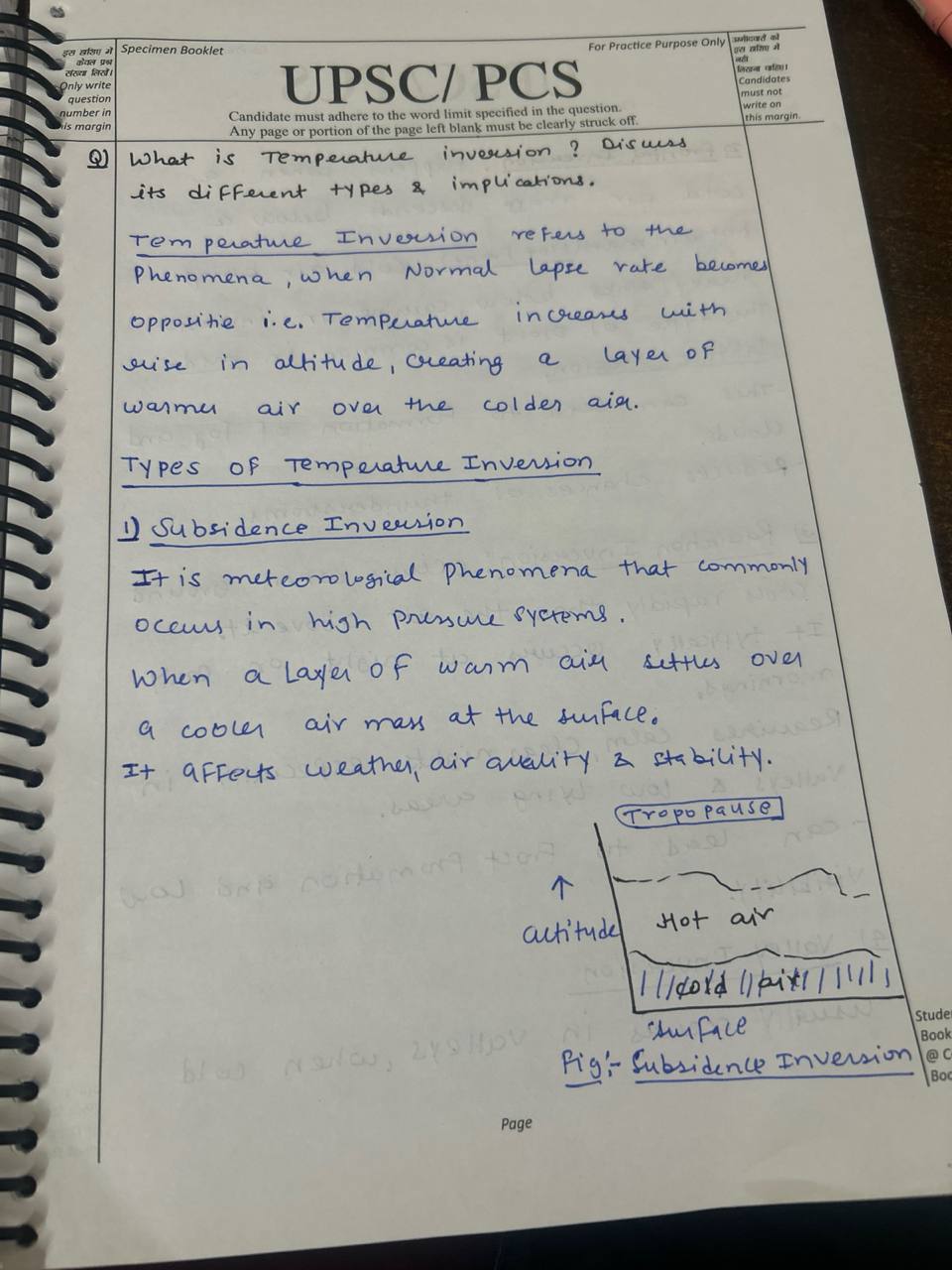Home/upsc: climatology/Page 2
- Recent Questions
- Most Answered
- Answers
- No Answers
- Most Visited
- Most Voted
- Random
- Bump Question
- New Questions
- Sticky Questions
- Polls
- Followed Questions
- Favorite Questions
- Recent Questions With Time
- Most Answered With Time
- Answers With Time
- No Answers With Time
- Most Visited With Time
- Most Voted With Time
- Random With Time
- Bump Question With Time
- New Questions With Time
- Sticky Questions With Time
- Polls With Time
- Followed Questions With Time
- Favorite Questions With Time

What factors contribute to the prominence of local winds in the Mediterranean region? How do these winds affect the regional climate and the daily lives of the people living there? (200 words)
Model Answer Complex Topography The Mediterranean region’s diverse geography, including mountain ranges, valleys, and coastal areas, significantly influences wind patterns. For instance, winds like the Mistral are channeled through valleys, gaining speed due to the funneling effect between mountainRead more
Model Answer
Complex Topography
The Mediterranean region’s diverse geography, including mountain ranges, valleys, and coastal areas, significantly influences wind patterns. For instance, winds like the Mistral are channeled through valleys, gaining speed due to the funneling effect between mountain ranges like the Alps and the Central Massif. These geographical features facilitate the development of strong local winds.
Air Circulations
The interaction of various atmospheric systems, such as cyclones from the Atlantic, anticyclones from the north, and cold air masses from continental interiors, is disrupted by the region’s relief features. This causes the formation of local winds such as the Mistral and Bora, which influence the regional weather.
Mediterranean Sea
The Mediterranean Sea’s differential heating compared to land leads to the creation of winds like the Etesian, which are strong northerly winds that provide a cooling effect during the hot summer months, especially in areas like the Aegean Sea.
Sahara Desert
The Sahara Desert contributes to the development of hot, dry winds like the Sirocco. These winds, originating from the desert, carry dust across the Mediterranean, influencing both the climate and air quality in the region.
Impact on Regional Climate and the Daily Lives of the People
Winds like the Sirocco carry dust particles from the Sahara, reducing air quality and potentially causing respiratory problems for the people.
Understanding these local winds is essential for adapting to their effects, ensuring sustainable living and economic stability in the Mediterranean region.
See lessWhat are air masses? Discuss the various types of air masses and their significance. (200 words)


See lessWhat is temperature inversion? Discuss its different types and their implications. (200 words)



See lessHow does the study of past climates inform current climate change mitigation strategies?
The study of past climates, often referred to as paleoclimatology, provides valuable insights that can inform current climate change mitigation strategies in several ways: 1. Understanding Natural Variability Historical Context: Analyzing past climate conditions helps scientists understand the naturRead more
The study of past climates, often referred to as paleoclimatology, provides valuable insights that can inform current climate change mitigation strategies in several ways:
1. Understanding Natural Variability
2. Identifying Drivers of Change
3. Lessons from Past Adaptations
4. Improving Climate Models
5. Informing Policy and Decision-Making
Conclusion
In summary, the study of past climates provides essential insights that inform current climate change mitigation strategies. By enhancing our understanding of natural variability, identifying key drivers of change, learning from historical adaptations, improving climate models, and informing policy, paleoclimate research plays a crucial role in addressing the challenges of contemporary climate change.
See lessDiscuss the role of ocean currents in regulating global climate and weather systems.
Ocean currents play a vital role in regulating global climate and weather systems through their influence on heat distribution, nutrient cycling, and atmospheric interactions. Here’s a detailed overview of their impacts: 1. Heat Distribution Thermal Regulation: Ocean currents transport warm water frRead more
Ocean currents play a vital role in regulating global climate and weather systems through their influence on heat distribution, nutrient cycling, and atmospheric interactions. Here’s a detailed overview of their impacts:
1. Heat Distribution
2. Climate Zones
3. Nutrient Cycling
4. Interactions with the Atmosphere
5. Long-term Climate Changes
Conclusion
In summary, ocean currents are integral to regulating global climate and weather systems. They distribute heat, influence weather patterns, cycle nutrients, and interact with the atmosphere, all of which contribute to the Earth’s climate stability. Understanding and monitoring these currents is essential for predicting climate changes and managing their impacts.
See lessAnalyze the impact of deforestation on regional climates and global carbon cycles.
Deforestation has profound effects on both regional climates and global carbon cycles. Here’s a detailed analysis: Impact on Regional Climates Temperature Increases: Forests play a crucial role in regulating local temperatures through shade and evapotranspiration. Deforestation reduces these coolingRead more
Deforestation has profound effects on both regional climates and global carbon cycles. Here’s a detailed analysis:
Impact on Regional Climates
Impact on Global Carbon Cycles
Conclusion
In summary, deforestation significantly impacts regional climates by altering temperature and precipitation patterns and leads to biodiversity loss and soil degradation. Globally, it disrupts carbon cycles by releasing stored carbon, reducing carbon sequestration, and creating feedback loops that exacerbate climate change. Addressing deforestation is crucial for mitigating these impacts and promoting sustainable climate practices.
See lessHow do international agreements address climate change, and what challenges do they face?
International agreements play a crucial role in addressing climate change by establishing frameworks for cooperation, emission reduction targets, and funding for mitigation and adaptation efforts. Here are some key agreements and their associated challenges: Key International Agreements United NatioRead more
International agreements play a crucial role in addressing climate change by establishing frameworks for cooperation, emission reduction targets, and funding for mitigation and adaptation efforts. Here are some key agreements and their associated challenges:
Key International Agreements
Challenges Faced
Overall, while international agreements provide a necessary framework for addressing climate change, significant challenges remain that require sustained commitment and cooperation among nations.
See lessDiscuss the socio-economic implications of shifting climate zones on migration patterns.
Shifting climate zones due to climate change have significant socio-economic implications for migration patterns. Here are some key points to consider: Displacement: As certain regions become less habitable due to extreme heat, flooding, or drought, populations may be forced to relocate. This is parRead more
Shifting climate zones due to climate change have significant socio-economic implications for migration patterns. Here are some key points to consider:
Overall, the socio-economic implications of shifting climate zones on migration patterns are complex and multifaceted, requiring coordinated responses from local, national, and international stakeholders.
See lessEvaluate the relationship between climate change and the frequency of extreme weather events.
The relationship between climate change and the frequency of extreme weather events is increasingly recognized by scientists. Here are some key points: Rising Temperatures: Climate change leads to higher average global temperatures. Warmer air can hold more moisture, which intensifies precipitationRead more
The relationship between climate change and the frequency of extreme weather events is increasingly recognized by scientists. Here are some key points:
Overall, while not every extreme weather event can be directly attributed to climate change, the evidence suggests that climate change is influencing the frequency and severity of many types of extreme weather events.
See lessHow does climate variability influence water resource management in different regions?
Climate variability significantly influences water resource management across various regions, affecting availability, quality, and distribution of water resources. Here’s an analysis of how these dynamics play out in different contexts: 1. Impact on Water Availability Droughts: Increased frequencyRead more
Climate variability significantly influences water resource management across various regions, affecting availability, quality, and distribution of water resources. Here’s an analysis of how these dynamics play out in different contexts:
1. Impact on Water Availability
2. Regional Variability
3. Quality of Water Resources
4. Infrastructure and Adaptation Strategies
5. Socio-Economic Implications
6. Future Projections and Planning
Conclusion
Climate variability profoundly influences water resource management, requiring region-specific strategies to address the unique challenges posed by changing precipitation patterns, water quality issues, and socio-economic pressures. By adopting integrated and adaptive management approaches, regions can enhance resilience to climate variability and ensure sustainable water resources for future generations.
See less